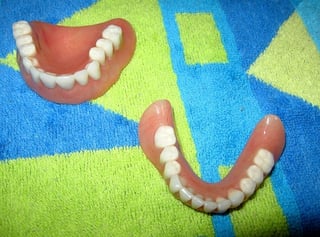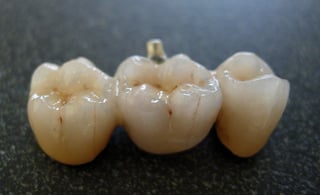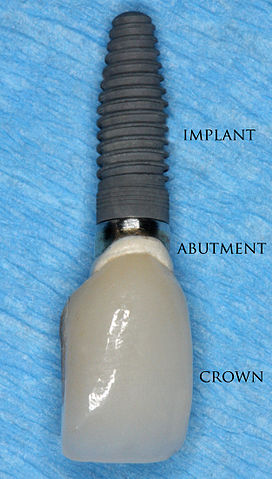
While it’s certainly preferable to be able to make it through life with all your own natural teeth, tooth loss can happen with age. Whether because of some sort of trauma, a health condition that results in loose teeth, or years of poor oral hygiene, many older Americans have to face the question of how to replace some or all of their natural teeth so they can continue to eat properly and enjoy the quality of life they deserve.
But, how can seniors decide among all the different options available for tooth replacement? Let’s consider what’s available, then we’ll discuss three main considerations that should factor into the ultimate decision.
What options are available for senior tooth replacement?
There are a number of different styles available in each, but the basic options available for senior tooth replacement fall into the following four categories:
- Partial Removable Dentures
- Full Removable Dentures
- Fixed Bridges
- Dental Implants
Partial removable dentures
 As the name implies, this form of dentures is designed to replace some — but not all — of the natural teeth with synthetic lookalikes. To function, it requires healthy teeth that can be used to anchor and stabilize the denture.
As the name implies, this form of dentures is designed to replace some — but not all — of the natural teeth with synthetic lookalikes. To function, it requires healthy teeth that can be used to anchor and stabilize the denture.
The device is custom-made for the patient based on a mold of their mouth. And, ideally, the synthetic teeth are colored to match the patient’s natural tooth coloring since seniors often experience teeth yellowing as they age. While the fact that the appliance is removable means it’s going to require special care and take some getting used to, a partial removable denture offers a relatively inexpensive option for replacing one or many teeth.
Full removable dentures
 Full dentures are made much like partial dentures, but they are designed to replace all the teeth on top or bottom, or both, if necessary. Since no healthy teeth are available for anchoring the appliance, it remains in place via a combination of form-fitting pressure, natural suction, and mild adhesive (such as Fixodent). Implant-anchored full dentures are also available, although, at perhaps 10X the price, they haven’t quite caught on for most patients yet.
Full dentures are made much like partial dentures, but they are designed to replace all the teeth on top or bottom, or both, if necessary. Since no healthy teeth are available for anchoring the appliance, it remains in place via a combination of form-fitting pressure, natural suction, and mild adhesive (such as Fixodent). Implant-anchored full dentures are also available, although, at perhaps 10X the price, they haven’t quite caught on for most patients yet.
Again, like partial dentures, full dentures will require the wearer to bite and chew carefully, and they will need to be cared for meticulously to avoid potentially dangerous chafing and bacterial buildup. For patients facing severe tooth loss, however, this is a small price to pay for regaining the ability to eat, talk, and smile naturally.
Fixed bridges
 Fixed bridges are designed to “bridge” the gap left by one or more missing teeth in a row. Traditionally, this is accomplished by grinding down the healthy teeth on either side of the gap, then fitting each of them with a crown with one or more replacement teeth connecting them. In recent years, implant-anchored bridges have grown in popularity because they don’t require any damage to be done to healthy teeth in order to support the bridge.
Fixed bridges are designed to “bridge” the gap left by one or more missing teeth in a row. Traditionally, this is accomplished by grinding down the healthy teeth on either side of the gap, then fitting each of them with a crown with one or more replacement teeth connecting them. In recent years, implant-anchored bridges have grown in popularity because they don’t require any damage to be done to healthy teeth in order to support the bridge.
Fixed bridges can and should last for many years and can be brushed and otherwise cared for just as you do your natural teeth. While the materials used for older bridgework may have been somewhat weaker or more brittle than natural tooth enamel, modern bridges can generally withstand all the same bite pressure and normal wear that your natural teeth can handle.
Dental implants
 The final option to consider for tooth loss is also the most recently devised: dental implants. Unlike the other tooth replacement options, getting implants is a minor surgical procedure in which a small, threaded post is screwed directly into the jawbone to serve as a permanent artificial root and an artificial tooth (really, a crown) is attached to the post via an abutment.
The final option to consider for tooth loss is also the most recently devised: dental implants. Unlike the other tooth replacement options, getting implants is a minor surgical procedure in which a small, threaded post is screwed directly into the jawbone to serve as a permanent artificial root and an artificial tooth (really, a crown) is attached to the post via an abutment.
Because the implants are surgically attached to the jawbone — much like your natural teeth — there is almost no special care or caution required once you've healed from surgery. Dental implants tend to be just as strong and resilient as natural teeth, and can generally last a lifetime without special attention.
The main potential drawback of choosing dental implants over another form of tooth replacement, however, is cost. While a partial removable denture replacing one tooth can cost as little as $700, a single tooth implant can cost as much as $4,000.
How can a senior decide what form of tooth replacement to get?
Considering all of the above, making a decision on what form of tooth replacement to get comes down to three basic factors patients should carefully consider with the help of their dentist:
- Cost
- Functionality
- Maintenance
Cost
"Unlike the other tooth replacement options, getting implants is a surgical procedure in which a small, threaded post is screwed directly into the jawbone to serve as a permanent artificial root and an artificial tooth is attached to the post via an abutment."
The options listed above range in price from a few hundred dollars to nearly $100,000, depending on the number of teeth that need to be replaced and the quality of the materials chosen.
Typically, your dentist can help you determine how to best meet your tooth replacement needs without destroying your budget. It’s important to investigate options for insurance coverage, discounts, and financing opportunities, too.
For example, most dental insurance plans will cover a portion of the cost of partial or full dentures up to whatever the plan limitations allow. Dental implants, on the other hand, are often excluded by many plans.
As a dental insurance alternative, dental discount plans will generally include dentures and implants in their discount programs if they offer discounts on orthodontics and other advanced services.
Check with your dentist directly to find out if they have any sort of financing options available for patients exploring tooth replacement.
Functionality
Beyond the cost of the appliance you choose, how it works and how well it’s going to hold up are also important considerations.
For example, is the option you choose going to have a significant impact on what kinds of food you’re able to eat going forward? Is it going to make it unwise to engage in one or more activities you enjoy? How long can you reasonably expect it to last before needing repair or replacement due to normal wear and tear?
These factors may seem less important in the short term, but over time, choosing an option that forces you to miss out on foods or activities you enjoy, or that’s prone to damage, can be frustrating and cumbersome.
Maintenance
Finally, consider what it’s going to take to maintain the tooth replacement option you choose.
One of the reasons dental implants are so expensive is because, once they’re installed, you never have to think about them again. You just go on treating them like your natural teeth, including daily brushing and flossing, and they respond just as you’d expect them to.
Removable dentures, on the other hand, require near-constant attention from being cautious with how you use them to the nightly cleaning/soaking routine. So, you need to be honest with yourself and decide if you’re willing and able to take on that responsibility. If not, the fact that dentures are less expensive than implants won’t matter because you’ll just be throwing that money away.
If you’re currently struggling with tooth loss and trying to decide how to handle tooth replacement, we hope the above information has been helpful. We also encourage you to speak with your dentist and let them guide you to the best option for you.

